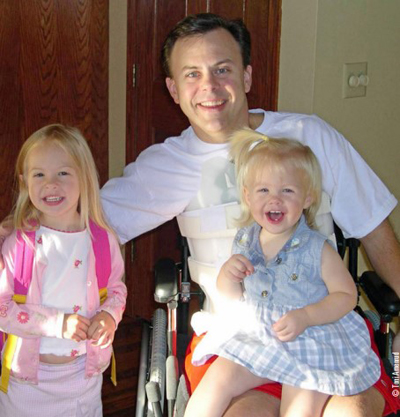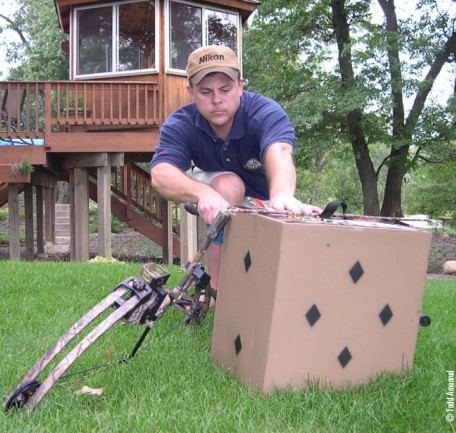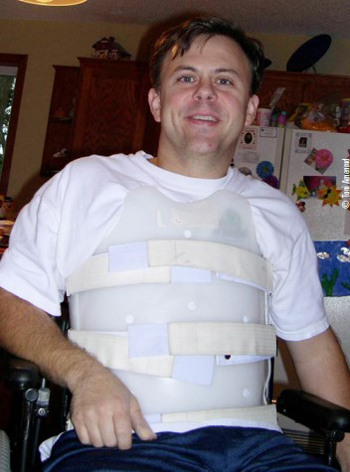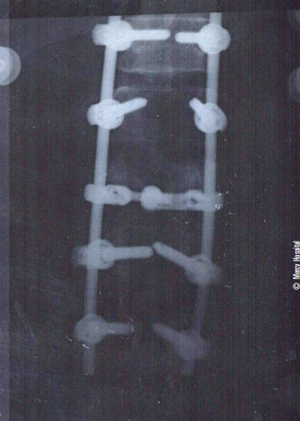Bob Humphrey | Originally published in GameKeepers: Farming for Wildlife Magazine. To subscribe, click here.

There’s a saying in prize fighting: “Everyone has a plan…until they get hit.” Like a boxing match, life occasionally throws us a blindside punch, something that comes seemingly out of nowhere and knocks us senseless. How we handle it not only determines if we’ll succeed; it can also define our character.
Round 1
Todd Amenrud had a plan, from a very early age. It was vague at first, but became increasingly more defined as he matured, and always steered him toward a passion for the outdoors. “I was born into an outdoor family,” he began. His dad, Randy, is a professional angler who was inducted into the National Fresh Water Fishing Hall of Fame and the Fishing Hall of Fame of Minnesota. His uncle, Willis Peterson, was head of agricultural economics at the University of Minnesota. Among Todd’s earliest memories are the stories his dad and uncle would tell of their trips up north to deer camp. “It was part of our culture.” He said. “There might be anywhere from a dozen to 20 guys who would go to our northern Minnesota deer camp each fall and I couldn’t wait until the day I’d be old enough to join them.”
Round 2

from a three month stay at two different hospitals. He’s
pictured with his two daughters Veronica and Sophia, who
at the time were only four and one.
The budding outdoorsman was so insistent in harassing his father to take him hunting that his dad offered a compromise one day and promised to take him around their home the year he turned seven. “I can still remember it clearly. It was the last day of deer season and Dad was watching the Vikings game. I kept nagging him until he finally agreed to take me as soon as the game ended. Then, he grabbed the old Model 12 Winchester and one box of slugs and we went for a walk behind the house.”
The father-son team had barely hit the edge of the timber when they jumped two deer. “It was a doe and “nubbin” buck,” Amenrud recalled. “Dad grabbed my jacket and said ‘C’mon. I know where they’re going.” After a 250-yard dash the duo hopped a fence and walked quickly back into the woods. “Dad stood me against a tree, handed me the Winchester and said “don’t move.” Half a minute later, here they came.”
This was it, the moment Todd had been waiting for all of his…to that point rather short life. The doe ran past but the young buck stopped long enough for the novice hunter to make a shot. “The buck ran maybe 50 yards and fell, but he wasn’t dead. My dad said we needed to stop it from suffering; and that’s when my seven year old nerves went to crap. First I shot it through the rear hock, then the ear. Then I missed it clean. I was down to my last shot when dad told me to calm down and breathe.” The last shot was perfect and Amenrud had his first deer.
Round 3
“I remember Dad would brag about it to anyone who would listen. That praise just reinforced my desire and every day after school I would get off the bus and run to the woods to try and sneak up on whatever I could ‘til eventually I got pretty good at sneaking up on whitetails.” By age 12, Todd was finally going up north with the crew. “Since it’s legal to “party hunt” and a lot of the guys went up to camp more to bend their elbows than seriously hunt, I would fill their tags. I got to be good at killing deer.”
The outdoors wasn’t just a hobby for the Amenrud family. He began with his first job at the age of 15 at Total Sports, a sporting goods chain in the Upper-Midwest that was dissolved many years ago, where he worked in the hunting, fishing and camping department. He then traveled the road as a sporting goods rep handling a number of hunting and fishing lines, and then covered the state of Wisconsin for a large wholesaler called Carlson Sports, Inc.—that through sales and mergers is now called Big Rock Sports.
Todd and his brother, Troy, owned Amenrud’s Woods & Water during the 80s—it was a hunting and fishing retail store in the northern suburbs of Minneapolis. He then worked for another family business that he now owns, Outdoor Promotions and Communications, Inc. And it was through this venture that Amenrud first became acquainted with Mossy Oak. “It was their (Mossy Oak’s) second year in business and they signed as one of our company’s clients,” said Amenrud. And then in the 90’s, Mossy Oak was also one of the sponsors for my syndicated television show, “In the Outdoors.”
Float like a Butterfly...

archery hunter, and still is. Luckily, the injury hasn’t prevented him
from hunting with a bow.
Life was suddenly very busy for Todd. At first he worked part time for family businesses while going to college at the University of Minnesota, MacPhail Center for Music. He eventually took over the family’s company as its president in the mid 90’s.
Like his father, Todd was a visionary and innovator. “My Dad, and his original partner, Gary Roach, worked in the fishing end of things. In fact, my Dad was the first person to really develop this business model of promotion in the fishing tackle industry. I saw how that worked in fishing and asked him to help me bring it to the hunting industry.” Within his first two years in business he had some big clients, Including Remington, Wildlife Research Center, PSE and Mossy Oak. And it wasn’t long before Amenrud’s relationship with the latter began to grow.
“When Biologic came to be, they asked if I would slide it into our Mossy Oak contract,” he said. “We took them on eagerly. Because of my family’s background in managing wildlife and agriculture, I saw this as something I was very interested in.” Amenrud was also a devout fan of Dr. Grant Woods, whose research on food plots and nutrition was the foundation for Biologic. “I saw it as an opportunity to learn things I wanted to learn. I also saw the incredible demand their products had in my neck of the woods.”
...Sting like a Bee
During this entire time, deer hunting was becoming a passion, and more to Amenrud. “Hunting deer was becoming my thing,” he said. “During the late 80’s and 90’s, Myles Keller was my guru. The challenge of bowhunting has always been one main reason why I love it. I wanted to hunt big deer with a bow.” And he got pretty good at it. “I’d spend three months of the year in Manitoba hunting. Back then there was plenty of access, great habitat and no hunting pressure. A lot of folks up there hadn’t even thought of bowhunting for whitetails.” Amenrud started racking up the big bucks, and being in the outdoor industry, folks started taking notice.
Cruising
That, and his professional background and experience got him more directly involved with Mossy Oak and other long-time partners like Wildlife Research Center. “My first job directly working for Mossy Oak Biologic was as a Sales Manager for the Upper Midwest, which eventually evolved into managing the whole northern half of the country.” Personally and professionally, Amenrud was living the dream as both his vocation and avocation steered him toward the outdoors. In the “boxing match of life” Amenrud was clearly ahead on points cruising toward an easy, unanimous victory.
Body Blow
July 4, 2004—Amenrud was getting ready to celebrate our nation’s birthday much like millions of typical Americans, with a barbecue and fireworks. “I had built a gazebo on our back deck and was staining the shaker shingles, the absolute last thing on the entire project, before everything would be finished and ready for the event.” He had a smile on his face and not a care in the world as he wiped the sweat from his brow and stood to stretch. In the blink of an eye, his whole world was about to change, precipitously and irrevocably.
Still holding a can of stain in one hand and a brush in the other he started sliding down the roof. “I was sliding standing up. It’s funny how your mind races in situations like that and I was remembering being a kid and jumping out of my grandparents’ hay loft.” But this was no hay loft. Amenrud fell 26 feet, landing on his feet, on a concrete slab. The impact sent a shock wave of pain through his body. “I knew right away something very bad happened,” he said. “I went down and couldn’t move anything below my arms. “My wife ran out but didn’t realize what had happened until, after catching my breath I managed to mouth the words nine-one-one, nine-one-one!”
Help was quick to arrive in the form of the local Sheriff, then first responders and an ambulance, and it soon became obvious Amenrud’s injuries were severe. “The ambulance driver told my wife they used enough morphine to knock out four guys twice my size and it still hurt like hell.” In X-rays taken in the emergency room it appeared as if his L-1 vertebra was GONE and the T-12 was damaged badly. This was serious!
Down for the Count
The first few days after the accident were fraught with both physical and emotional pain as Amenrud and his family slowly came to grips with his situation. He spent two and a half weeks in Mercy Hospital in Anoka, MN simply waiting for swelling to go down enough that they could operate. He said, “The surgeon told my wife, Toni, not to expect much, I’d probably never walk again.”

was the brace he had to wear to inhibit movement.
When the day came when he was allowed to take it
off, he brought it outside and shot it with a 12 gauge.
The surgery lasted 13 hours. They took bone from his hip to repair his L-1 vertebra that had exploded. They also repaired his shattered left ankle. When he immerged his wife could hardly recognize him because of all the swelling. He would stay in intensive care for another 10 days. At this point no one knew whether the surgery would be successful or not. Would he regain any function below the waist?
Saved by the Bell
After surgery he was moved to the Sister Kenny wing of Abbott Northwest Hospital in Minneapolis for therapy and rehab. And it was there that he began to consider what the rest of his life would look like—his job and his family. “I thought about what I could say to Toxey (Haas). Would I be able to do my Job? How am I going to support my family?”
Coaching in the Corner
Amenrud had only been home for a day when he received a call from his boss, Bobby Cole. “He put me on speaker phone in Toxey’s office. I had already rehearsed my speech and I began telling Bobby, ‘I can do this (job) from my wheelchair.’ I could hear Toxey’s office chair squeak and could picture him leaning back in it, like he does, listening to the conversation,” he said. Then he heard Haas in the background addressing Cole: “You tell him not to worry about a thing. He’s got a job when he’s ready and a paycheck in the meantime. Just tell him to concentrate on getting better.” Amenrud was floored by the action. “I cannot tell you how grateful I am for that, and the loyalty I feel towards Toxey and his company because of it and other gestures shown to myself and others over the years. People who work for Mossy Oak are treated more like family than co-workers.”
The blow knocked Amenrud to the ground both literally and figuratively. One minute he was living a life so many of us only dream of, the next it had seemingly all been taken away. He had survived the physical punishment, but now faced a psychological and emotional battle the likes of which most people can’t possibly comprehend. He had reached a crossroads in life with two choices and at first he took the more difficult route. “It was a long, hard process,” he recalled. “One of the things I remember hating most about it was this stupid cast I had to wear. It was a hard plastic shell, like a suit of armor, the most uncomfortable thing I ever had on.”

from Amenrud’s hip to replace the shattered
L-1 vertebra, and installed two titanium rods
with eight screws into his backbone to
stabilize the area around the injury.
Ironically, the accident occurred on “Independence” Day, but he spent over a year in a wheelchair bound and very “dependent.” He worked hard on the physical battle, as best he could—“I did all the work, therapy and exercises, whatever they asked me to do”—but was losing the psychological battle.
“I felt sorry for myself at first,” he humbly admitted. “I remember that first year, September rolled around and the leaves began to change color...” he hesitated. “I’ve never told anyone this until just recently...,” he continued. “After the kids were off to school and my wife left for work I would roll down the ramp my brother had built, sit in my driveway and bawl my ass off for hours feeling sorry for myself.” Amenrud began to question whether he’d be able to come out punching when the bell rang for the next round.
Answering the Bell
“Then one day it snapped. I thought, ‘I can sit here and be miserable or I can do something about it.’” Amenrud was never alone during the process. “Everyone was offering help, but I had to do it for myself to prove I could still do it.” So he began the process that had once been so much a routine of his life that he often went through the steps quickly and mechanically, without much thinking. But this time was different. “It was such a chore just to do simple things like breaking out all my hunting clothes, washing them and hanging them out to dry. Luckily I’ve also had support from another company who are also like family to me, Wildlife Research Center. The Burgesons’ and the entire crew at Wildlife have always been incredibly supportive and gave me the tools necessary to make the job of preparing much easier than it could have been.”
It took me about a week or more to do all the preparation necessary.” With that done, he then bought a new crossbow. “I didn’t know at that time if I would be able to draw my bow. Luckily I could, so I never got to use my new crossbow.”
Then, the fateful day arrived. “I got the ATV ready. I can remember transferring from my wheelchair to the ATV. Then, I drove to a spot where I thought I would be far enough away from the deer but could still make the journey easy enough.” Then, he put his bow on his back and literally crawled on his hands and knees almost 200 yards to a creek bank. He backed into a cedar tree, sat up against the tree and snipped a couple shooting lanes. So far, so good. It wasn’t long before the action started. “I guess because I crawled in so silently, I didn’t know it at the time but I had crawled in amongst some bedded deer.”
It was about an hour before dark when he heard a commotion. “A doe and a fawn got up from their beds behind me and started stretching. Then he heard more noise... “Maybe 40 yards in front of me, this buck hopped up and ran up onto the creek bank.” The buck heard the other two deer so his attention was focused on the doe and fawn.” This offered Amenrud the opportunity to draw and loose a fatal shot. Todd found himself in tears again, but this time for a different reason. “I was bawling because I was so happy, I had proven myself.”
Split Decision

not knowing he had crept to within 40 yards of where this
buck was bedded. A doe and fawn rising from their bed on
the opposite side of him created a commotion that
captivated the buck’s attention so he was able to draw and
put a good shot on the buck.
Todd’s accident and perhaps even more the recovery after, has given him a new perspective. When asked if he considers himself limited or handicapped he answered; “I don’t look at it that way but yeah, you have to. I don’t get around as well or as fast as I used to, but I do get around. Rather than go into the deep tangled cover I have to pussyfoot around the edges, if you will.”
He has also gained a new perspective. “For me it always has been, and still is about the challenge. I used to enjoy sneaking along with a recurve and shooting mature whitetails “mano de bucko” on the ground, but I understand that’s not feasible anymore so sitting in a ground blind or a treestand works now; that’s my challenge.” And yes, he did say “treestand.” “I was a little leery of treestands for a couple years but now I use them, mostly ladder stands now.” He continued, “Being a gamekeeper and my job have been the best therapy I could think of. Spending a few hours on a tractor or running a chainsaw calms my nerves and “points my compass north.” Actually, all that I’ve learned from a long career in the outdoor industry has made me pretty good at managing a property for big whitetails. This, in turn, has made it much easier for me to still have a good chance at killing big whitetail bucks. In fact, some of my best scoring trophies have come since my accident.
“I now walk with a cane,” he described. “It’s like walking on stilts wherever I go and being shot with novocaine from my belly-button down. It’s weird, and very difficult. Everyone always says, “God has a plan for you.” I used to think; sure, that’s what someone with perfect use of their legs would say. But now I understand. If because of my handicap my daughters have learned to handle adversity better than the average kid, perfect - things like that help me cope. I hope my actions and what I have to deal with teach them good lessons all the time.”
Amenrud now works as Director of Public Relations, Editor-in-Chief of GameKeepers, and (in his words) “whatever Bobby thinks I should be doing on any given day.” He also relies more on ATVs for transportation—“They’re my legs, sometimes”—and more importantly, family and friends. “It was a life-changing accident but what’s the alternative? You could sit there and feel sorry for yourself, or move on and enjoy what you can. I learned a lot in the process.” Amenrud ultimately chose the latter and in doing so offers an inspirational example of overcoming adversity. He was able to find inner strength that he, at first didn’t realize he had. Then, on a strong foundation of family, faith and friends he built a new life.































